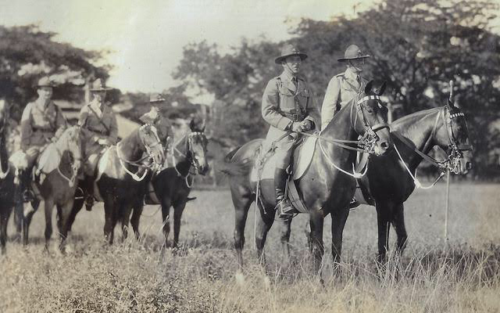
Maj. John B. Anderson (center foreground) in the Philippines, 1926. An Iowa farm boy, Anderson knew how to ride horses. Photo courtesy of Anderson/Van Ness Collection
Part 1 of 2
(Publisher’s note: This is the first of a two-part series about Maj. Gen. John B. Anderson written by his grandson, Michael M. Van Ness, who has also written a biography about his grandfather, “General In Command: The Life of Major General John B. Anderson.” Our cover story focuses on Anderson’s Iowa roots, education at West Point and his service during World War I and the 1929 Geneva Convention. Part two of the series will appear in the Nov/Dec issue of IHJ.)
By Michael M. Van Ness
United States Army Maj. Gen. John B. Anderson, née Andersen, was born on March 10, 1891, in Parkersburg. His parents, Karl and Louisa, were Danish immigrants and farmers. An adventuresome boy, he left the family farm to see the world.
His ambition led him to West Point. He adopted West Point’s motto, “Duty, Honor, and Country,” as the foundation for a lifetime of achievement. A “Forest Gump” character, he was present at many of the most significant events of the 20th century. He rubbed shoulders with the greats before falling — like Icarus — to the earth.
He was an “Everyman” who rose from humble beginnings to touch the stars, literally. Like so many of his era, he achieved greatness. He loved and lost; he stumbled and fell; and until recently, he was lost to the ages. Here is his story.
Growing up in Parkersburg
In 1891, Anderson’s mother was 47 years old. His father was 43. Both were Danish natives. While their first son, Nels, was born in Denmark in 1865, life was difficult with endless wars and periodic famines. In contrast, the large, peaceful Danish community in Iowa was flourishing. Land was cheap and the government was welcoming. With the prospect of a new life, they emigrated to Iowa in 1872.
Louisa and Karl lived quietly and comfortably on their Butler County farm. They spoke Danish at home and worshipped as they pleased. They had four more children in quick succession, the last in 1882, or so they thought. In 1891, along came “Ben,” an “oops” baby, or “tail-gunner Charlie.” Now they had another mouth to feed. Ever devout, they reasoned it was God’s will and dug a little deeper.
Ten years later, as Anderson entered his teen years, the family began to scatter. Nels was the first to go. During the 1898 Spanish-American War, he volunteered for the Iowa National Guard, he served in California, and after the war he remained in San Francisco. Anderson’s sisters wed, one after the other, and left the farm to start families of their own. After 1900, an ever greater share of the work fell on Anderson’s shoulders.
At the same time, the U.S. was rocked by change. President William McKinley was assassinated in 1901; “Rough Rider” Teddy Roosevelt of San Juan Hill fame came to the rescue. When the Wright brothers flew a heavier-than-air flying machine in 1903, people were electrified; “Man can fly!” When the apocalyptic 1906 San Francisco earthquake struck and fire burned the city to the ground, Anderson prayed for Nels who survived but lost all his possessions. When the 1908 “Race Across America,” a hare-brained publicity stunt to spur automobile sales, passed through nearby Des Moines, Anderson watched in disbelief. And in 1909, when American explorers Robert E. Peary and Matthew Henson reached the North Pole, anything seemed possible.
Anderson decided, “No more farming!” Instead, he would follow the example of his older brother Nels and go into the U.S. Army. Always a “striver,” he secured appointments to both the U.S. Naval Academy in Annapolis and the U.S. Military Academy in New York. West Point would be his ticket.
TO READ THE ENTIRE STORY AND OTHER FASCINATING STORIES ABOUT IOWA HISTORY, subscribe to Iowa History Journal.
